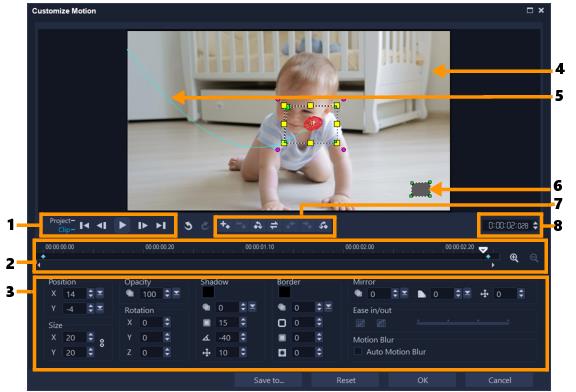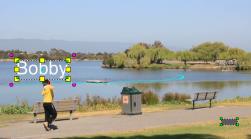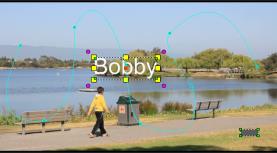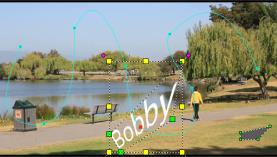Customizing motion
Using the Customize Motion feature, you can manually set the motion of overlays and titles to complement the motion of elements in a background video (without reference to any existing tracking information). This means that you can define your own motion path and modify various properties to create simple or complex motion effects. For example, using keyframes, you can control the size, opacity, and rotation of an object as it moves across the path you set for it. You can also gradually ease the motion in or out and apply a motion blur with Auto Motion Blur that matches the movement of the selected object as it moves along the path.

Adding Auto Motion Blur (example on right side) applies a blur that corresponds to the movement of the selected object as it moves along the path.
You can save a custom motion to the Library as a path, with or without other property settings.

Customize Motion dialog box
Part | Description |
|---|---|
1 — Playback Control | Buttons that control video playback. |
2 — Timeline Control | The Video Timeline along with zoom controls. |
3 — Attribute Panel | Defines the Position, Size, Opacity, Rotation, Shadow, Border, Mirror and Ease in/out controls. |
4 — Preview Window | Shows the current video being played. |
5 — Motion path | The path of the motion as manually defined. This is shown only in the Customize Motion dialog box. |
6 — Object distortion window | Controls the orientation of the video clip / overlay object. |
7 — Keyframe Control | Adds, removes and controls the position / offset of key frames. |
8 — Timecode | Lets you jump directly to a specific part of the video by specifying the exact timecode. |
• Right-click a video clip on the Timeline and choose Motion >Customize Motion.
You can also open the Customize Motion dialog box by clicking the Effect tab from the Options Panel, and then clicking the Advanced Motion option. This option is available only when a clip is selected on the Overlay Track.
1 Right-click a background video or an overlay clip in the Timeline and select Motion > Customize Motion. The Customize Motion dialog box opens.
In this example, the title is shown with a straight line motion path.

2 Change the shape of your motion path by dragging line segments and key frame nodes.

Note: Key frame nodes are automatically added every time you move to another frame and make a modification. You can also create a key frame node by dragging the scrubber and clicking the Add key frame button  .
.
 .
.3 Adjust the properties of your title depending on the requirements of your project.
Each time you set a value, a key frame is added.
The example below shows the title after adjusting Position, Size and Rotation values.
If you want to change the center reference for the object (to offset rotation or zoom effect), in the preview window, drag the red centre marker to a new position

Note: You also have the option to change the opacity, add a shadow and border, and mirror your image by adjusting the values under Opacity, Shadow, Border, and Mirror. Clicking the Ease in/Ease out button  /
/ allows the motion to start out slowly or slow down as it comes to an end. Drag the slider to control the easing in and out timing. In addition, you can enable the Auto Motion Blur check box to automatically add a motion blur to the moving object.
allows the motion to start out slowly or slow down as it comes to an end. Drag the slider to control the easing in and out timing. In addition, you can enable the Auto Motion Blur check box to automatically add a motion blur to the moving object.
4 Play the video to test your animation. When done, click OK.
If an existing tracking path is customized, existing match motion information in the video will be converted to a generic moving path.
1 After you create a custom motion in the Customize Motion dialog box, click Save to.
2 In the Save to Path Library dialog box, type a name in the Path name box.
3 Choose one of the following Options:
• Path with all attributes — saves the path and the attributes assigned to the keyframes
• Path only — saves the path only; no other attributes are saved
4 In the Save to drop-list, choose a folder.
1 In the Timeline, right-click a clip that has custom motion applied, and from the context-menu choose Motion > Remove Motion.